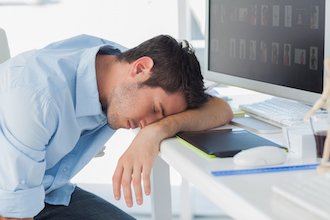After obstructive sleep apnea, narcolepsy is the second leading cause of daytime sleepiness. It is a neurologic disorder that can cause someone to fall asleep while engaging in any activity, including working, driving, or having a conversation.
Narcolepsy Signs and Symptoms Include:
- Automatic behavior, which can involve continuing with an activity despite being asleep. People who experience automatic behavior do not remember the activity in which they participated during sleep
- Excessive daytime sleepiness, which can be accompanied with inability to concentrate, excessive yawning, poor performance at work or school, irritability, relationship problems, and depression
- Hypnagogic hallucinations, which are vivid, often frightening dreams that occur while falling asleep or waking
- Muscle weakness and loss of muscle control (cataplexy) that often results from emotional stress
- Sleep paralysis
- Uncontrolled sleep episodes in which a person falls asleep abruptly without necessarily feeling sleepy
Diagnosing Narcolepsy
Although the most common symptom of narcolepsy is excessive daytime sleepiness, muscle weakness and loss of muscle control (cataplexy) can help identify the disorder in some people. In many cases, sleep experts use more than 1 approach to diagnose narcolepsy.

To Diagnose Narcolepsy, Practitioners Can Use:
- Blood test to measure antigens that are common in people with a family history of narcolepsy. Although blood tests are not always conclusive, they can help determine the possibility of narcolepsy in some people
- Epworth sleepiness scale — a sleep questionnaire that allows the participant to rank and assign a value to situations that cause sleepiness
- Multiple sleep latency test (MSLT) — a test that measures the length of time it takes to fall asleep during the day as well as sleep patterns during naps
- Nocturnal polysomnogram — a test that measures electrical activity in the brain (electroencephalogram) and heart (electrocardiogram) as well as movement in the muscles (electromyogram) and eyes (electro-oculogram). Most people who have a polysomnogram stay overnight at a sleep center to have the test
Treating Narcolepsy
Treatment for narcolepsy can include lifestyle changes as well as counseling, medication, and behavioral changes.
Counseling can help people with narcolepsy cope with some of the emotions, including fear and depression, as well as behaviors such as becoming withdrawn that can accompany the disorder.
Narcolepsy Symptoms Can Benefit from Certain Medications, Including:
- Stimulants such as methylphenidate (Ritalin) and amphetamines to help keep the nervous system active
- Modafinil (Provigil), which can promote wakefulness. Compared with other stimulants, modafinil is less habit forming and has fewer side effects
- Antidepressants (selective serotonin reuptake inhibitors and tricyclics), which doctors prescribe to help suppress the (rapid eye movement or REM) sleep cycle, lessen symptoms of cataplexy, reduce hypnagogic hallucinations, and reduce sleep paralysis
- Sodium oxybate (Xyrem), which is taken at night to improve sleep, reduce daytime sleepiness, and help control cataplexy, sleep paralysis, and hallucinations
Tips for Coping with Narcolepsy Include:
- Avoiding stimulants such as caffeine and nicotine
- Divide large tasks into small, manageable tasks on which you can focus
- Keeping a routine sleep schedule that includes going to sleep at the same time each night and waking at the same time each morning
- Letting others know what to expect, including your employer, coworkers, and friends
- Napping for 10- to 15-minutes several times each day to help prevent excessive daytime sleepiness and unexpected sleep episodes
- Standing whenever possible
- Taking several short walks each day to promote wakefulness
- Getting the emotional support you need with professional counseling or by joining a support group
- Do not drive if you are sleepy, nap before you drive
- Do not operate dangerous machinery
- Use a tape recorder to record important conversations and meetings
